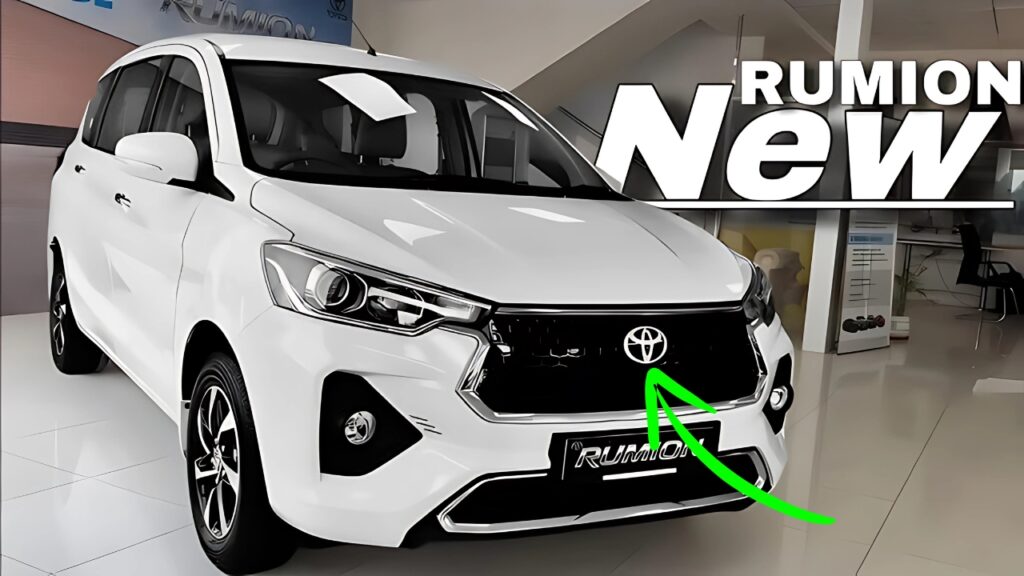Toyota Rumion: The fast-paced Indian automotive arena has welcomed a strong contender in the Multi-Purpose Vehicle (MPV) segment – the Toyota Rumion.
This new model from the renowned Japanese automotive manufacturer is not just another option for consumers. It’s here to challenge the dominance of the Maruti Suzuki Ertiga and potentially transform the MPV landscape as we know it. Let’s explore how the Rumion could alter the market dynamics and if it has what it takes to introduce a new standard.
Despite sharing a platform with the Maruti Suzuki Ertiga, Toyota has ensured that the Rumion feels unique, aiming to establish a distinct persona in a crowded market.
Design Philosophy: Familiar Yet Distinct
At first sight, the Rumion may remind you of the Ertiga, but Toyota has taken deliberate steps to set its model apart:
-
A reimagined front grille adorned with prominent Toyota branding
-
An aggressive bumper design for a dynamic posture
-
Distinct alloy wheel patterns introducing a sporty flair
-
A sleek chrome embellishment connecting the taillights, elevating the luxurious experience
-
Exclusive color choices such as Spunky Blue and Rustic Brown
These design tweaks, albeit subtle, play a significant role in positioning the Rumion as a more upscale choice within the MPV sector.
Toyota Rumion Interior: Where Comfort Meets Technology
Upon entering the Rumion, you are welcomed by an interior designed to enhance expectations within the segment:
-
A sophisticated multi-color theme led by beige, promoting a sense of openness
-
Metallic wood accents throughout the dashboard, contributing to an upscale atmosphere
-
A segment-leading 9-inch touchscreen infotainment system offering wireless Android Auto and Apple CarPlay
-
A modern, 7-inch fully digital driver’s display, adding a contemporary touch
-
Ventilated front seats, a feature usually found in pricier vehicles
-
A pioneering 360-degree camera system exclusive in its class
These standout features not only set the Rumion apart from its immediate rivals, but they also reshape perceptions regarding the expectations for an affordable MPV.
Toyota Rumion Performance: Balancing Power and Efficiency
Under the hood, the Rumion follows a proven method:
-
A robust 1.5-liter K-Series petrol engine delivering 103 PS and 137 Nm of torque
-
Providing options with a 5-speed manual or a 6-speed automatic transmission
-
An available CNG variant producing 88 PS and 121.5 Nm of torque
Fuel efficiency ratings are commendable:
-
Petrol MT: 20.51 kmpl
-
Petrol AT: 20.11 kmpl
-
CNG: 26.11 km/kg
These figures solidify the Rumion’s place in an arena where operational costs greatly influence consumer choices.
Toyota Rumion Safety: Raising the Bar
Renowned for safety, Toyota maintains its reputation with the Rumion:
-
Standard dual front airbags
-
ABS featuring EBD
-
Rear parking sensors
-
ISOFIX child seat anchors
-
Hill Hold Control present in automatic variants
-
Side and curtain airbags in higher trims
-
Electronic Stability Control in top-tier models
This comprehensive safety arsenal not only meets but exceeds what competitors offer, possibly establishing a new standard for safety in the budget MPV category.
Toyota Rumion Pricing Strategy: A Calculated Gamble
Toyota’s pricing approach for the Rumion is particularly notable:
-
Price range: ₹10.44 lakh to ₹13.73 lakh (ex-showroom)
-
Available in three trims: S, G, and V
Despite being priced slightly above the Ertiga, Toyota is banking on its brand prestige and superior features to warrant the cost. This strategy has the potential to alter buyer perceptions in the segment, possibly compelling other brands to enrich their offerings or adjust their pricing schemes.
Toyota Rumion Market Impact: Ripples Across the Segment
The launch of the Toyota Rumion could reverberate throughout the industry, affecting more than just its competition with the Ertiga:
-
Elevating Consumer Expectations: By introducing premium features at an accessible price, the Rumion is setting higher standards for customer expectations in this sector.
-
Challenging Brand Loyalties: With the trusted Toyota name, the Rumion may entice customers who typically favor different brands in this market.
-
Expanding the Market: Rather than merely taking sales from existing players, the Rumion aims to lure buyers from outside the segment altogether.
-
Pressure on Competitors: With its extensive feature set and Toyota’s reputation for quality, other makers might be compelled to elevate their offerings, creating a ripple effect in the market.
-
Redefining Value Proposition: The Rumion’s position as a more luxurious model challenges the concept that economical MPVs must sacrifice features or quality.
Toyota Rumion Early Market Response and Future Outlook
Following its debut, the Toyota Rumion has created significant excitement within the Indian automotive sphere. While it’s premature to label it a triumph, initial feedback has generally been positive:
-
Dealerships are observing strong interest, as many potential buyers are attracted by the Toyota emblem along with the vehicle’s extensive feature set.
-
The Rumion is drawing not just typical MPV buyers but also those who might lean towards compact SUVs, indicating a unique blend of appeal.
-
Some consumers express readiness to spend more than what competitors demand, favoring Toyota’s reliability and strong resale values.
Despite its positive reception, challenges persist:
-
The higher cost relative to established choices like the Ertiga may deter some budget-minded buyers.
-
Maruti Suzuki’s substantial sales and service network gives the Ertiga a noteworthy edge, especially in rural locations.
-
Other manufacturers are likely to respond with upgrades to their product lines, heightening competition in the marketplace.
Looking to the future, the Rumion’s lasting success hinges on several critical factors:
-
Toyota’s Marketing Strategy: The effectiveness of Toyota’s promotion for the Rumion as a value-driven option, even at a higher price, will be essential.
-
After-Sales Support: Toyota’s ability to leverage its trusted reputation for service quality can set it apart.
-
Market Expansion: The Rumion’s capacity to attract customers from different segments will significantly influence its market effect.
-
Competitor Response: How swiftly and efficiently other automotive brands react to the Rumion’s entry will shape the segment’s future.
-
Economic Factors: Given the price-sensitive nature of the Indian economy, fluctuations in economic conditions and fuel costs can affect the Rumion’s appeal.
Toyota Rumion Conclusion: A New Chapter in the MPV Saga
The introduction of the Toyota Rumion signifies a pivotal moment in the Indian MPV landscape. While it might not immediately dethrone long-standing players, it holds the ability to reshape the market in numerous ways:
-
Transforming consumer expectations regarding features and quality in affordable MPVs
-
Challenging the pricing dynamics of the sector
-
Possibly broadening the MPV market by attracting new customers
For potential buyers, the Rumion’s arrival is undoubtedly welcome news. It introduces more options, improved features, and may stimulate competition across the entire category as rivals respond.
For Toyota, the Rumion embodies a daring initiative to enhance its share of the Indian market, with its success or failure likely influencing the company’s strategic direction in the coming years.
For competitive manufacturers, the Rumion signifies an alert that urges them to innovate and refine their lineups and pricing strategies.
As the market settles and the true influence of the Rumion unfolds, one thing is clear: the Indian MPV segment is gearing up for an exhilarating phase marked by innovation and transformation.
The subsequent months will prove vital in determining whether the Toyota Rumion can truly “outpace the competition” or simply become another option within this fiercely contested segment. Irrespective of the outcome, its bold entrance has already left a significant imprint on the Indian automotive industry.


